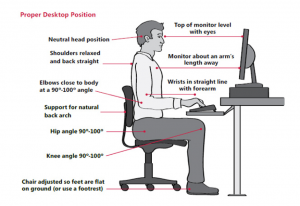ADVICE
Sit Properly!
I remember my mum saying it to me as a child, and now I say the same thing to my sons at mealtimes. In fact, we should all bear the order in mind, because sitting too much is the curse of modern life! I know that sounds a bit melodramatic, but countless studies show that leading a sedentary lifestyle contributes to obesity, cardiovascular disease, type-2 diabetes, as well as muscle and joint pain. Yikes!
Well, I accept that for most of us, being at a desk for a large proportion of the day is unavoidable. So, if we’re going to do it, let’s at least do it properly! Desk ergonomics are something that most employers are aware of and the chances are that if you regularly work in an office, your desk is set up in an acceptable way.
However, increasingly we spend more time working from home where the work station set-up may not have been given much thought. I’ve seen a significant number of people who complain of aches and pains in the back, neck and shoulders after spending more time than usual in front of a laptop at the kitchen table. Please, don’t do it! Making the effort to set up a work area that follows some basic rules isn’t difficult. Here’s a diagram that summarises the principal points of a seated work station.
Standing desks have become more commonplace in recent years. If you’re unaware of what they are, the name is self-explanatory; a standing desk is simply a desk that allows you to work comfortably at a screen whilst standing. The set-up principles are virtually identical to those above, except of course, you are standing.
Studies show that sitting less has a surprisingly positive impact on some quite diverse medical conditions. Here are a few: –
- People suffering with neck, shoulder and back pain who switch to standing desks report an improvement in their symptoms.
- A less sedentary lifestyle directly leads to weight loss and a reduced chance of developing cardiovascular disease and metabolic disorders like type-2 diabetes.
- In one study, the use of standing desks led to participants feeling less stressed, more energetic and happier.
So, if you’re looking to change the set-up of your work station, then consider a sit-stand desk, and if you do convert, do so gradually, beginning with standing for half the time.
If you’ve got a sitting desk with no prospect for change, just make sure you get the ergonomics right and negate some of the ill effects by getting up for a stretch and a stroll every 30 minutes or so.
Whichever kind of desk you use, incorporate more movement into your day; walk more, drive less, use the stairs, take your lunchbreak, visit your colleagues’ desks instead of emailing. You’ll feel the benefits, I guarantee it.

